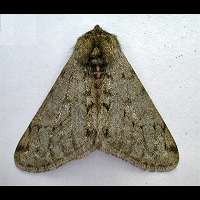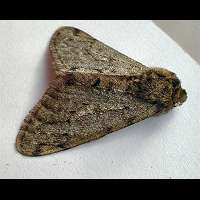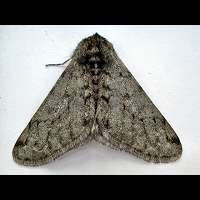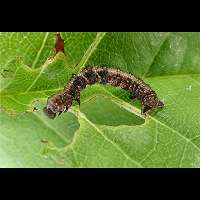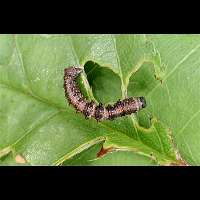Pale Brindled Beauty (Phigalia pilosaria)
The male Pale Brindled Beauty is a rather dull moth, looking more like an Owlet than like a Geometer. The ground colour is some kind of grey. At about two thirds of the wing there usually is a small blackish brown curved line and near the tip of the wing regularly a blackish spot is visible. It looks very much like the Small Brindled Beauty, which is smaller and which has the wing partly light grey towards the edge. It also looks a bit like the Brindled Beauty, which is much more clearly marked and flies a bit later. All these species also have melanistic forms, which range from darkish brown to blackish brown. In these cases look out for the following characteristics. The Pale Brindled Beauty is entirely unmarked, the Small Brindled Beauty clearly shows a lighter colour towards the edge of the wing and the Brindled Beauty usually still shows a white wavy line just before the edge of the wing. The Pale Brindled Beauty has a wingspan of some 45 to 50 mm. Females are wingless and look like a big, fat, 6-legged spider.
The eggs of the Pale Brindled Beauty hatch in April and the caterpillars feed till the end of June. Fullgrown the larva is rather fat, but tapers towards the head. It usually is greyish brown, being greenish brown at times. It has vague, reddish brown markings. On the back and sides there are some little bumps with a few hairs growing out them. These bumps are best seen in the middle part of the body and towards the tail. The head is greyish or greenish brown. The caterpillar will reach a length of some 38 mm. At first the larvae will eat buds which are still closed, later they'll eat the leaves. They feed by night and rest on the leaves of the host plants by day. By the end of June or the beginning of July they'll move to the ground, where they pupate in the ground. Numerous trees and shrubs serve as host plants. Especially popular are birch, oak and apple.
The Pale Brindled Beauty is single brooded and a real winter moth. In mild winters the first adults may appear in November or December. The main period of being on the wing for this species is January and February. It is still seen in March and April, but numbers are decreasing quickly in this period. Because of this very curious period of flying about, this species is usually easily identified. The males only fly by night, but aren't very active. During daytime they are regularly found resting on tree trunks, fences and walls. They are easily attracted to light. A typical species of woodlands, parks and gardens. A common species all over Britain, except for Ireland, Scotland and the Hebrides, where it is widespread, but less frequent. A common species over most of Europe as well.
Scientifically often still referred to by its former name Apocheima pilosaria.
The male Pale Brindled Beauty is a rather dull moth, looking more like an Owlet than like a Geometer. The ground colour is some kind of grey. At about two thirds of the wing there usually is a small blackish brown curved line and near the tip of the wing regularly a blackish spot is visible. It looks very much like the Small Brindled Beauty, which is smaller and which has the wing partly light grey towards the edge. It also looks a bit like the Brindled Beauty, which is much more clearly marked and flies a bit later. All these species also have melanistic forms, which range from darkish brown to blackish brown. In these cases look out for the following characteristics. The Pale Brindled Beauty is entirely unmarked, the Small Brindled Beauty clearly shows a lighter colour towards the edge of the wing and the Brindled Beauty usually still shows a white wavy line just before the edge of the wing. The Pale Brindled Beauty has a wingspan of some 45 to 50 mm. Females are wingless and look like a big, fat, 6-legged spider.
The eggs of the Pale Brindled Beauty hatch in April and the caterpillars feed till the end of June. Fullgrown the larva is rather fat, but tapers towards the head. It usually is greyish brown, being greenish brown at times. It has vague, reddish brown markings. On the back and sides there are some little bumps with a few hairs growing out them. These bumps are best seen in the middle part of the body and towards the tail. The head is greyish or greenish brown. The caterpillar will reach a length of some 38 mm. At first the larvae will eat buds which are still closed, later they'll eat the leaves. They feed by night and rest on the leaves of the host plants by day. By the end of June or the beginning of July they'll move to the ground, where they pupate in the ground. Numerous trees and shrubs serve as host plants. Especially popular are birch, oak and apple.
The Pale Brindled Beauty is single brooded and a real winter moth. In mild winters the first adults may appear in November or December. The main period of being on the wing for this species is January and February. It is still seen in March and April, but numbers are decreasing quickly in this period. Because of this very curious period of flying about, this species is usually easily identified. The males only fly by night, but aren't very active. During daytime they are regularly found resting on tree trunks, fences and walls. They are easily attracted to light. A typical species of woodlands, parks and gardens. A common species all over Britain, except for Ireland, Scotland and the Hebrides, where it is widespread, but less frequent. A common species over most of Europe as well.
Scientifically often still referred to by its former name Apocheima pilosaria.

